At the February 7 meeting of Northampton’s planning board, one member characterized as “carbuncles” condo developments that integrate poorly with their surrounding neighborhoods.
Let’s take a look at the characteristics of some attractive streets with detached houses in the North Street neighborhood, and then contrast them with three carbuncle candidates–two built and one proposed.
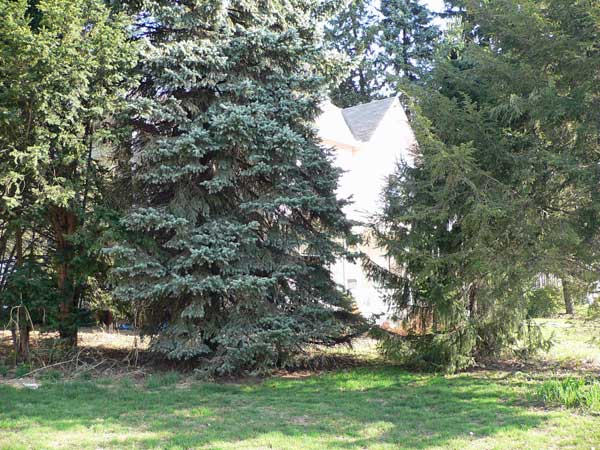
Trees between homes on North Street give shade and privacy
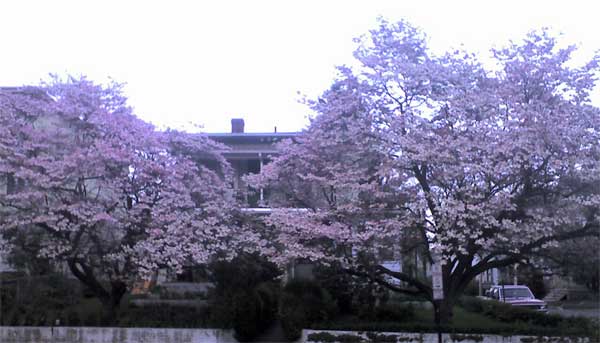
These trees on a private yard look well cared for and beautify the neighborhood. Urban Forest Landscapes reports that trees on private yards have a low mortality rate over a 30-year period (18%). By contrast, trees in parks, public housing, or along highways have a mortality rate of 39% (p.185, Chicago Benefit-Cost Study).
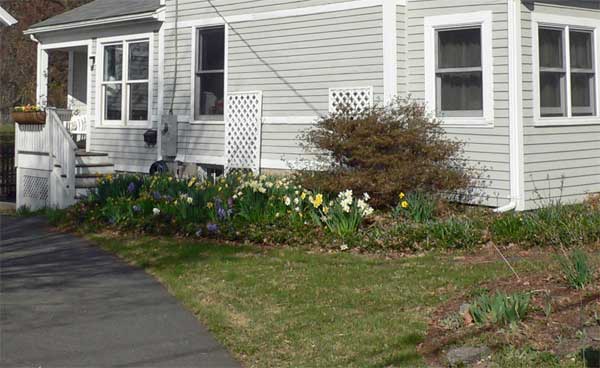
Greenspace between homes permits residents to cultivate flower, herb and vegetable gardens
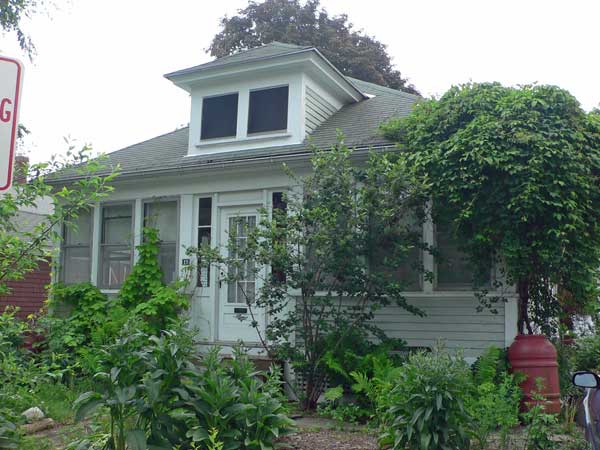
This intensely gardened home on Northern Avenue has edible plants growing on all four sides
Below are houses on a loop through North Street, Bates Street, the new bike trail, and Woodmont Road. Note the remarkable variety of sizes, styles, price points and configurations. Some houses are one-family, others more. Some are owner-occupied, others are rentals. The net result is a neighborhood that attracts people with a diverse mix of incomes, ages, jobs and living situations. The varied and distinctive personalities of each house, the lawns and gardens, and numerous large, handsome trees are key components of the charm of our neighborhood.
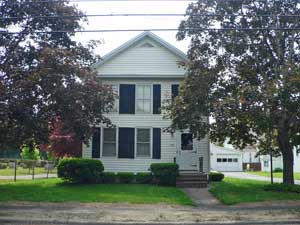
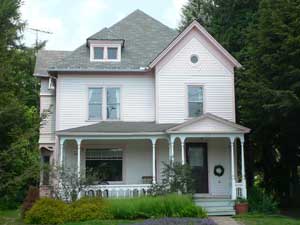
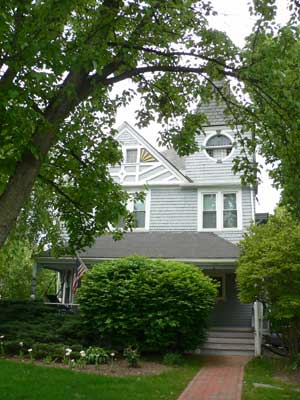
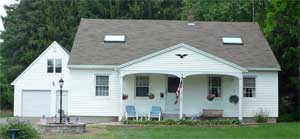
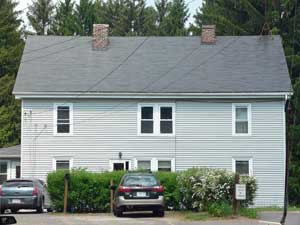
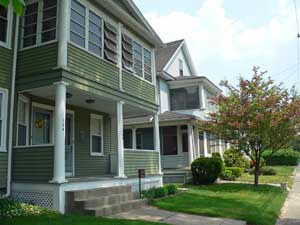
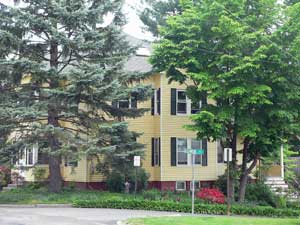
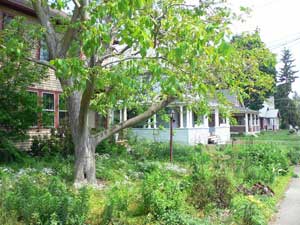
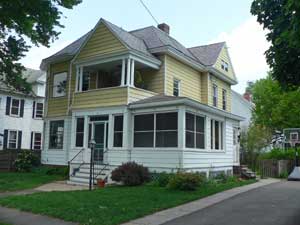
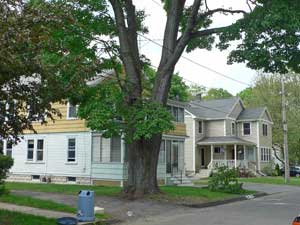
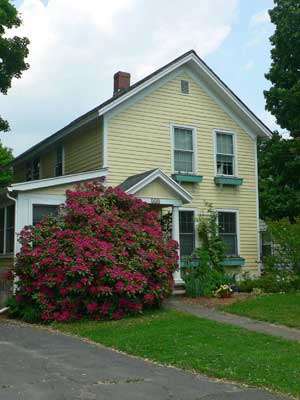
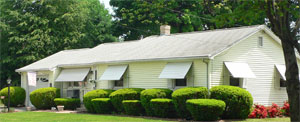
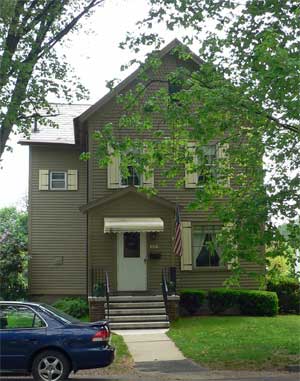
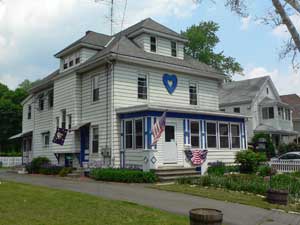
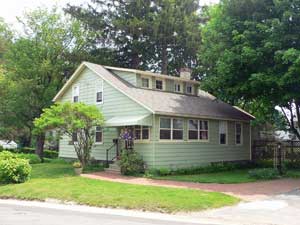
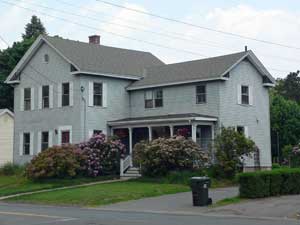
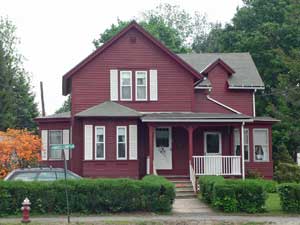
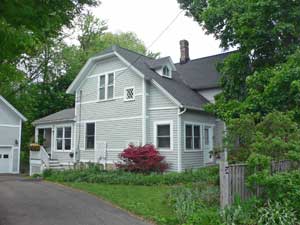
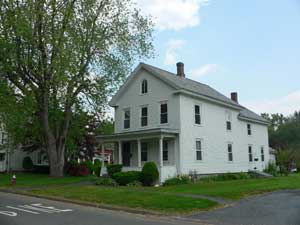
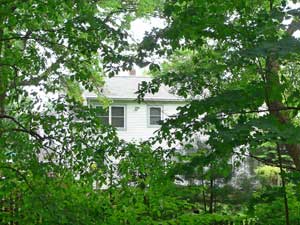
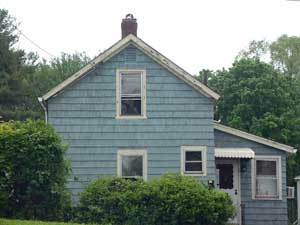
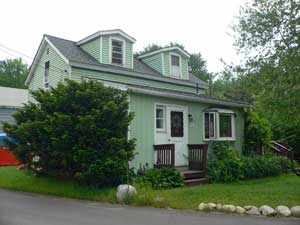
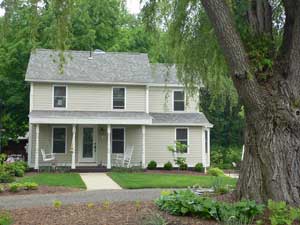
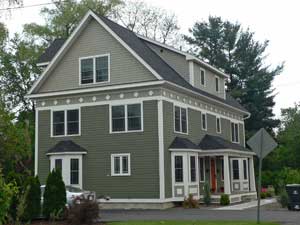
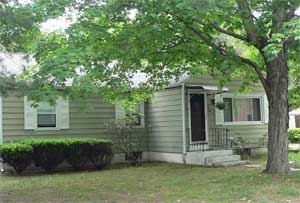
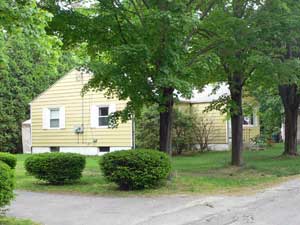
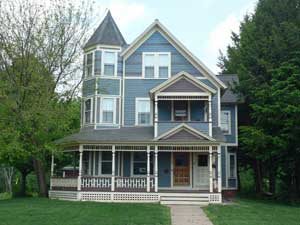
Now let’s contrast the above to two relatively new condo developments in Ward 3 and a third one proposed by Kohl Construction. Some general points to note:
- The condo units look closely similar. They lack individuality. Beyond questions of aesthetic appeal, they may not attract as wide a range of residents as the more diversified stock above. Families with small children, for example, may be put off by the lack of private yards.
- The Hockanum and Bixby condos have a large footprint relative to their lot sizes. Relatively little greenspace remains. In particular, it’s hard for these developments to accommodate as many large trees and their extensive root systems. This is another hit to attractiveness and deprives the condos of the shading and windbreak properties of trees and their ability to absorb water.
- Due to the volume of impervious surface, the Hockanum and Kohl condos call for detention ponds to manage excess flows of water. As the city has discovered at Northampton High School and Carlon Drive, these wetlands mitigation schemes can perform badly if not carefully maintained. They can form breeding grounds for mosquitoes and present a safety hazard for children.
- To maximize profits, the developers have shoehorned units into their lots with little regard to the preexisting appearance of their neighborhoods. The developments feel inward-facing or ‘withdrawn’, not part of the regular street fabric. These aspects are probably what prompted the “carbuncle” comment from the planning board member.
This is the condo development on Hockanum Road:
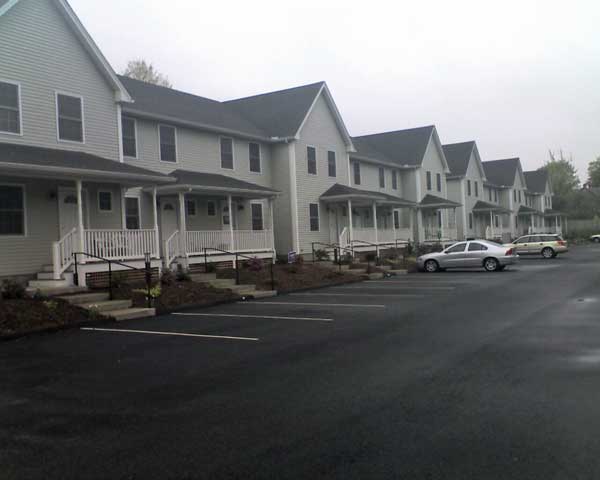
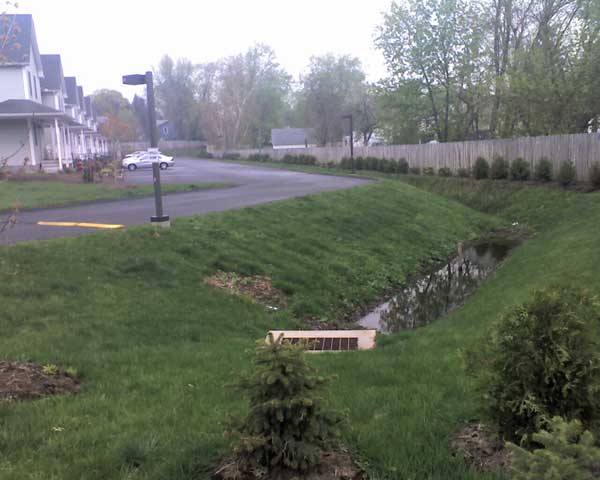
Hockanum condo detention pond
This is the development at Bixby Court:
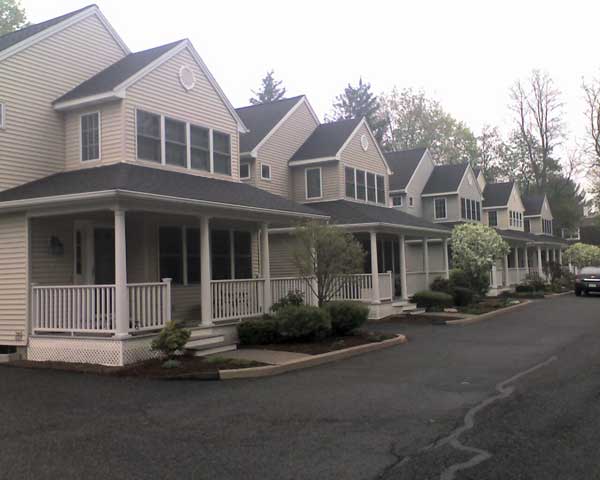
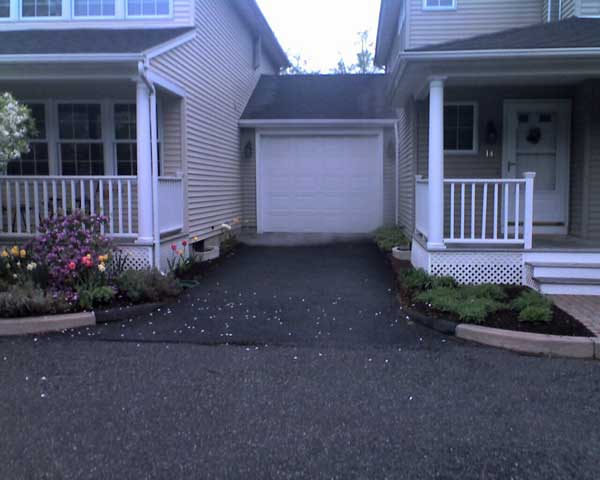
These closely packed units have a garage in between, rather than greenspace
The condo development below has been proposed by Kohl Construction (see most current update) for the wooded area behind North Street:
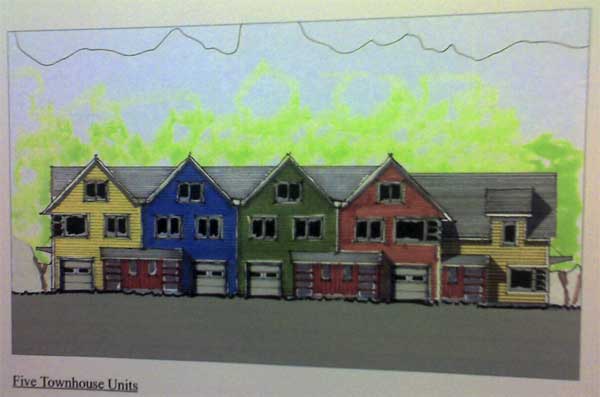
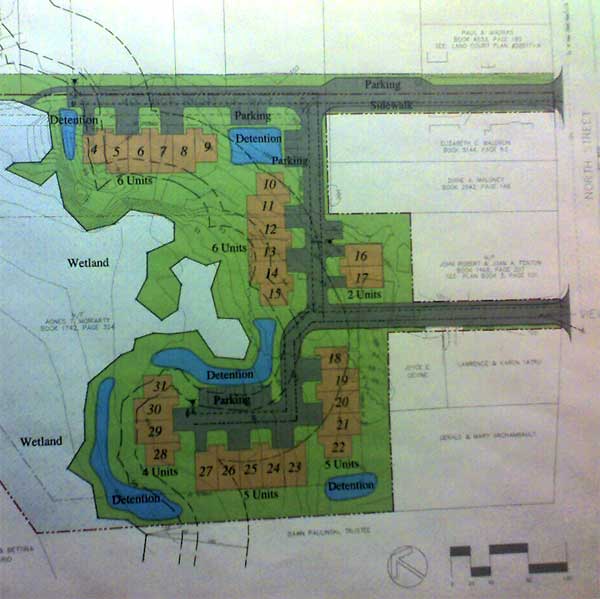
The roads and condos are slated to encroach within 35 feet of wetlands
If a trend towards dense, monotonous developments gains momentum, we can expect to see larger effects on Ward 3, such as higher temperatures, more air pollution, more traffic congestion, a greater risk of flooding from the spread of impervious surface and encroachment on wetlands, and an overall reduction in charm and beauty. This is not inevitable, but it appears we need to adjust our zoning to preserve what’s good about where we live. Let your city councilors know how you feel.
See also:
An Update from the Ward Three Neighborhood Association (5/20/08)
…Our second committee, the Sustainability Committee, is charged with reading the city’s new Sustainability Plan and keeping the board updated on issues relating to Ward 3. The committee has focused on the proposal to rezone many neighborhoods throughout the city (including many in Ward 3) for much denser development, and this has the potential to become a really hot potato. We’re ahead of the curve on this issue and will make sure Ward 3 residents have ample notice of any proposed meetings and/or zoning changes. Jim Nash and Owen Freeman-Daniels have been instrumental in forming the committee and are looking for more residents to join.
The New Draft Sustainable Northampton Plan: Balancing Compact Growth Against Taxes, Urban Greenspace, Homeowner Preferences
An
objective of the Plan is to “implement ideas for maximizing density on
small lots”. (p.16) It calls for the City to “consider amending zero
lot line single family home to eliminate 30′ side yard setback”. (p.69)
Planning Board Adopts Sustainable Northampton Plan
[New
language in Plan:] “Traditional Neighborhood and Receiving Zone — These
are currently the most developed areas with planned expansion of
developable area to accommodate expected demand for new growth. These
areas can accommodate the vast majority of new smart growth residential
development… More focus on design details, encouraging designs
compatible with historic neighborhoods, focus on pocket and linear
parks and on the quality of life generally are key elements for
encouraging a population density consistent with the highest quality
neighborhoods present 50 years ago.”
…[NSNA
is] concerned…about the reference to densities of 50 years ago. Much
has changed since then. In particular, women have far more jobs outside
the home, meaning more cars are on the road. By the same token, more
families have become too busy to dedicate an adult to shopping in small
amounts on a daily basis. If you’re buying 50 pounds of groceries and
supplies at a time, you’re probably going to prefer to do that by car
rather than walk or use the bus. Factors like these mean that a
neighborhood that had comfortable density in 1957 might be perceived as
congested with cars today.
Pictures of Northampton Streets at Various Densities
Downstreet.net: Despite Tree City USA Honor Northampton Planting Lags
…developers,
both residential and commercial, often regard landscaping and tree
requirements as an unwarranted expense, not as a benefit to the quality
of life to the city’s inhabitants…
UMass Press: “Natural Land: Preserving and Funding Open Space”
Preserving
areas of nature, open space, and trees and other vegetation can have
psychological as well as physical health benefits for local residents.
There is a growing body of research which points to the power of nature
to restore people from the stress of modern life, including mental
fatigue (Kaplan, Kaplan, and Ryan 1998; Frumkin 2001).
Greening Smart Growth: The Sustainable Sites Initiative
The
presence of natural elements has several implications for personal and
community security. Shared green spaces, particularly those with trees,
provide settings for people to interact and strengthen social ties.
Residential areas with green surroundings are associated with greater
social cohesion in neighborhoods, and neighbors with stronger social
ties are more likely to monitor local activity, intervene if problem
behaviors occur,[48] and defend their neighborhoods against crime.[49]
Residents of buildings with greater tree and grass cover report fewer
incidences of vandalism, graffiti, and litter than counterparts in more
barren buildings.[50] Likewise, a study comparing police reports of
crime and extent of tree and grass cover found that the greener a
building’s surroundings, the fewer total crimes were reported.[51]
Photo Essay: 10 Reasons People Like Trees Around Them; Will the Sustainable Northampton Plan Put Urban Trees at Risk?
If you walk down North Street, imagine most trees between houses gone
and replaced with a near-solid wall of housing. See the articles below,
and decide if that’s growth that’s smart, or growth that smarts…
“Planning for Trees” by Henry Arnold, Planning Commissioners Journal, January/February 1992
A
recent survey by the American Forestry Association of twenty American
cities found that, on average, only one tree is planted for every four
removed…
Our urban centers need to become more attractive to
help counter the continuation of a sprawl pattern of development. If
the appeal of low density, widely scattered development is derived from
the need to be closer to nature, then making trees an integral part of
the urban habitat will help make our town and city centers more
desirable places to live and work. It is profoundly important to see
this linkage between making cities and towns more “liveable” and
stemming the continued spread of scattered development across the
countryside.
“Green Enhances Growth” by Edward T. McMahon, Planning Commissioners Journal, Spring 1996
…today,
tree protection ordinances are sprouting up all over the country. In
California and Florida alone almost two hundred communities now have
city tree ordinances…
In 1991, the [Urban Land Institute], in
cooperation with the American Society of Landscape Architects, examined
eleven real estate developments to assess whether money spent on site
planning, landscaping, and preservation of mature trees justified the
added cost of development…greenspace and landscaping translated into
increased financial returns of 5 to 15 percent depending on the type of
project. Landscaping also gave developers a competitive edge and
increased the rate of project absorption…
[A National
Association of Home Builders] report points out that “lots with trees
sell for an average of 20 to 30 percent more than similarly sized lots
without trees,” and that “mature trees that are saved during
development add more value to a lot than post construction landscaping.”
…[A
1995 survey by American Lives shows] that “consumers are putting an
increasingly high premium on interaction with the outdoor environment
through the inclusion of wooded tracts, nature paths, and even
wilderness areas in housing developments.” In fact, 77 percent of
consumers put “natural open space” as the feature they desired most in
a new home development…
“Growing Greener: Conservation Subdivision Design” by Randall Arendt, Planning Commissioners Journal, Winter 1999
A
national survey of homebuyers conducted in 1994 by American Lives
revealed that of 39 features critical to their choice, homebuyers
ranked “lots of natural open space” and plenty of “walking and biking
paths” as the third and fourth highest rated factors affecting their
decisions…
Although the groundwater impact of an individual
development may not be terribly significant, the cumulative effect of
hundreds of acres of native woodland and meadows being evenly graded
and covered with streets, driveways, patios, rooftops, and lawns (which
allow for a surprisingly high amount of runoff) can be very
considerable.
“On the Value of Trees and Open Space” by Elizabeth Brabec, Planning Commissioners Journal, Summer 1993
Trees
reduce air pollution by filtering dust out of the air, reduce noise and
light pollution, reduce soil erosion and water run off, and aid in
climate control. Research has shown that properly placed trees and
landscape plantings can save 20 to 25 percent of energy use in the home
for both cooling and heating…
The Ecological Cities Project: Greenspace in “The Humane Metropolis”
Rutherford Platt, “Regreening the Metropolis: Pathways to More Ecological Cities”
Portland: A Photo Tour of Spiraling Densification
…Rowhouses 1 shows some more
rowhouses in a former single-family neighborhood in east Portland.
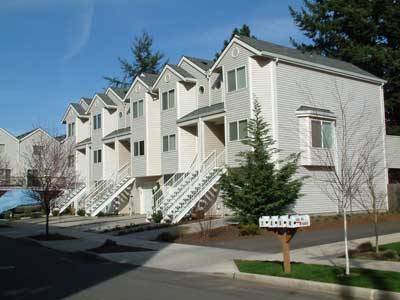
Rowhouses 1
But then planners decided even rowhouses weren’t dense enough, so
they began pushing for four- and five-story multifamily…
Portland, Oregon Voters Sour on Densification Over Time
…in 2002 Oregonians in Action wrote another initiative
seeking to take away Metro’s right to densify neighborhoods. Metro
responded with its own measure halting any densification until after
2015. During the campaign, Metro supporters claimed the Oregonians in
Action measure was supported by greedy speculators while Oregonians in
Action asked its supporters to vote for both measures. The Metro
measure received 66 percent of the vote; the Oregonians in Action
measure received only 42 percent. Both sides declared victory, but it
is evident that Metro submitted its own measure only because it feared
to fight a battle over density…
Still, many Portlanders remain unaware of the scope of the harm planners are doing to their city.
- They resent the congestion and the so-called traffic
calming projects, but they don’t realize that planners are deliberately
increasing congestion. - They resent the insider deals for urban-renewal projects,
but they don’t realize that those projects are part of a utopian plan
to get people to live in high-density housing. - They see families with children flee Portland for Vancouver
and more affordable distant suburbs, but they don’t realize that
unaffordable housing is the result of plans aimed at discouraging
people from living in a house with a large yard. - They worry about the $57 million hole in the Portland school
budget, but they don’t realize that that hole is the result of property
taxes taken from the schools to subsidize transit-oriented developments.
Metro Portland’s Long Experience with Smart Growth: A Cautionary Tale
Restrictive
growth policies actually caused increased suburbanization in Portland,
which now has the 10th greatest suburbanization rate in U.S. As home
prices went up in the site-restricted metropolitan area, families moved
further out to find affordable housing…
There is very little
evidence that other aspects of restricted growth policies have reduced
households’ costs in other areas to offset the increased costs of
housing. In economic terms, it is safe to say that restricted growth
policies are not family-friendly…
New York Times: “Vibrant Cities Find One Thing Missing: Children” (3/24/05)
After
interviewing 300 parents who had left the city, researchers at Portland
State found that high housing costs and a desire for space were the top
reasons…
Portland Suburb Successfully Staves Off Densification
Planners proposed to use minimum-density zoning, making it illegal to
build one house on a one-acre vacant lot. Instead, if a landowner built
anything at all, they would have to build at least seven houses on the
acre if it were zoned for 5,000-square-foot lots and at least a
20-unit-per-acre apartment if it were zoned for 24 units per acre. This
would lead to high-density infill in a low-density neighborhood, as is
happening in this Gresham neighborhood, which received such zoning
several years ago.
Scrape-Off Redevelopments Provoke Backlash in Denver Neighborhoods
Supporters [of lower-density zoning] said the increased density from the multiple-unit structures
was ruining the character of the two neighborhoods, which are comprised
of predominately single-family detached homes.
The outcropping of multifamily structures has cast shadows on gardens,
increased traffic and created parking wars, among other quality of life
issues, they said…
Our Column in Today’s Gazette: The Hidden Risks of ‘Smart Growth’
Steven Greenhut, a columnist for the Orange County Register, is critical of [Bozeman’s] Portland-style growth controls:
Creating unattractive and high-density projects in a place
awash in open space only pushes people farther out into the
countryside. In Belgrade, eight miles away, one finds market-driven
suburban-style subdivisions. That city does not have many restrictions,
and those who cannot afford Bozeman or who want a bigger place simply
move away, thus promoting the sprawl that Smart Growthers are trying to
stop…
LA Weekly: “City Hall’s ‘Density Hawks’ Are Changing L.A.’s DNA
The shift is pushing L.A. from its suburban model of single-family
homes with gardens or pools — the reason many come here — toward an
urban template of shrinking green patches and multistory buildings of
mostly renters…
“…The deal [says Yaroslavsky] is that there are a number of developers who see an opportunity here to make a killing.”
…density…breeds
much more crime — something “density hawks” never mention. A report by
the National Center for Policy Analysis says crime rates in dense
cities outpace by up to 20 percent the crime in more sprawling,
spacious cities. So-called “smart growth” Portland and Seattle lead the
pack in property crime…
LA Weekly: “What’s Smart About Smart Growth?”
Real estate developers have caught on, using the phrase shamelessly to
gain public support for enormous developments, from a hillside
subdivision near Santa Clarita to the Westside’s Playa Vista, the
massive, 5,800-home development near Marina del Rey. In a city where
growth was once a dirty word, smart growth is the spoonful of sugar
that suddenly makes bigness palatable…
Vancouver Sun: “Call it EcoDensity or EcoCity –either way it’s a hard sell”
Despite Yaletown, almost 70 per cent of the city is single-family
housing. Vancouver, essentially, remains an urban suburb. And there is
a reason for this.
People love it.
They love the city’s
garden-like nature. They love the stability and social cohesion of a
single-family neighbourhood. They like having neighbours they know…
Berkeley, California: Cautions on Infill
As noted recently in the Planet, the Berkeley Planning Department has
received an infill development award from the American Planning
Association (APA). How can this be? you ask. After all, Berkeley has
recently been engulfed in a storm of land use controversy, a stack of
lawsuits and appeals, and new Big Ugly Buildings strikingly similar to
those that initiated the Neighborhood Preservation Ordinance in 1973…
…propelled by their
simplistic “smart growth” philosophy, [the Planning Department] encourages developers to
build the largest possible projects over neighborhood objections…
The Planning Department is
well on its way to building a high-density downtown Berkeley that has
almost no parking… could rapidly become a problem for our business
community…
In 1990, 60 percent of New Yorkers said they would live somewhere else
if they could, and in 2000, 70 percent of urbanites in Britain felt the
same way. Many suburbanites commute hours every day just to have “a
home, a bit of private space, and fresh air.” But unfortunately,
running off to suburbia or to the wilderness to find contentment is
becoming environmentally and economically unviable.
We must draw
people back into relatively compact urban areas. Showcase cities that
have managed to attract would-be suburbanites into increased core
densities have done so through neighborhood revitalization and by
giving priority to quality of life, not density. This is the opposite
of what Berkeley is doing…
Renters and other high-density
residents are expected to do without adequate living space, greenspace,
quiet, and cars; and without cars, they lack the freedom, pleasure, and
mobility taken for granted by average Americans. This is ethically
unacceptable…
We cannot let planners and developers decide
what we will do with our lives. I never hear planners discussing
psychological health and cultural values. Planners have a different
approach. As one Berkeley planner told me, no matter what they build,
eventually those who can or must tolerate the new, worse environment
will replace those who can’t. As this happens, resistance to further
degradation lessens. But I reject this “race to the bottom.” And with
enough time, planners and developers could also train Americans to live
like drones in anthills—but why let them?
Smart Growth and Crime
…[Newman’s] 1972 book Defensible Space…showed that the safest neighborhoods maximized private space and minimized common zones…
“The larger the number of people who share a communal space,” [Newman]
found, “the more difficult it is for people to identify it as being in
any way theirs or to feel they have a right to control or determine the
activity taking place within it.”
…”I am not very impressed with the work of the New Urbanists,” Newman
wrote shortly before he passed away in April 2004. “It is nostalgia–a
throwback to the past, with little thought about what made those
environments work then (long-term occupancy by an identical economic
class and ethnic group), and unworkable today. The residential
environments they are creating are very vulnerable to criminal
behavior, unless, of course, these environments are exclusively
occupied by high-income groups.”
Journal
of Planning Literature: “Is it Safe to Walk? Neighborhood Safety and
Security Considerations and Their Effects on Walking” (February 2006)
…The
role and importance of the built environment in promoting physical
activity (or at least not impeding it) is a relatively new area of
research that has received increasing attention by scholars…
A
1994 U.S. Department of Transportation survey found that half of the
respondents would walk or walk more if there were safe pathways and
crime was not a consideration. Bauman et al. (1996) found that
perceived safety was one of the most important environmental qualities
for walking. In a survey that questioned Ontarians about their walking
habits, Hawthorne (1989) found that safety from crime was one of the
most appealing features for walking…
Studies have shown that environmental
barriers to walking such as safety are high among low-income people
(Craig et al. 2002), who often live in small apartments and houses with
no backyards or adequate space to exercise. A national telephone survey
found that twice as many low-income (31 percent) as moderate-income (15
percent) respondents identified worry about safety in their
neighborhoods as an obstacle to physical activity (Moore et al. 1996 in
Sallis et al. 1998)…
Seeing Like a State: Planning Gone Awry in the 20th Century
Scott critiques Brasilia, a super-modern city inspired by the concepts
of Le Corbusier…
…the built environment affects those who dwell in it.
Compared to life in Rio and Sao Paulo, with their color and variety,
the daily round in bland, repetitive, austere Brasilia must have
resembled life in a sensory deprivation tank……[T]here is little doubt that [Jacobs] has put her finger on the
central flaws of hubris in high-modernist urban planning. The first
flaw is the presumption that planners can safely make most of the
predictions about the future that their schemes require… Second,
thanks in part to Jacobs, we now know more about what constitutes a
satisfactory neighborhood for the people who live in it, but we still
know precious little about how such communities can be fostered and
maintained. Working from formulas about density, green space, and
transportation may produce narrowly efficient outcomes, but it is
unlikely to result in a desirable place to live. Brasilia and
Chandigarh, at a minimum, demonstrate this…Once the desire for comprehensive urban planning is established, the
logic of uniformity and regimentation is well-nigh inexorable. Cost
effectiveness contributes to this tendency… [E]very concession to
diversity is likely to entail a corresponding increase in
administrative time and budgetary cost…
Scott concludes by calling for a healthy respect for diverse lifestyles
and the wisdom of ordinary people. In the case of Northampton, we urge
planners to respect the preferences of families with children, as this has been a major issue in other Smart Growth cities like Portland.
The power and precision of high-modernist schemes depended
not only on bracketing contingency but also on standardizing the
subjects of development…This subject was singularly
abstract… Standardized citizens were uniform in their needs and even
interchangeable. What is striking, of course, is that such
subjects–like the “unmarked citizens” of liberal theory–have, for the
purposes of the planning exercise, no gender, no tastes, no history, no
values, no opinions or original ideas, no traditions, and no
distinctive personalities to contribute to the enterprise…To
the degree that subjects can be treated as standardized units, the
power of resolution in the planning exercise is enhanced. Questions
posed within these strict confines can have definitive, quantitative
answers…
Smart Growth Hazard: A Confining Sameness
Smart Growth Winners (Rich People) and Losers (Other People)
Reason.org: “The Human Face of Smart Growth Opposition”
…skeptics
of smart growth share many of the same concerns that its advocates have
about future growth and development – traffic congestion, environmental
degradation, reduced housing affordability, outdated planning codes
that prevent innovative developments, to name a few. The difference is
that the smart growth skeptics are not willing to buy into a “grand”
solution to these challenges.
And why shouldn’t they be
skeptical? After nearly a century of urban planning, the latest
solution to the planning mistakes of the past and challenges of today
is…you guessed it…more planning. The last major urban planning fad –
the nationwide urban renewal efforts of the post-WWII era – was sold
with the promise of dramatically reinvigorating cities and improving
urban life, but the actual result was the wholesale destruction of
vibrant urban neighborhoods and the large-scale stifling of inner city
economic opportunity. It is not unreasonable to be wary of the latest
planning fad, especially when so much is at stake for our families and
communities.
Energy-Efficient Personal Vehicles of the Near Future
Smart Growth advocates are concerned about the energy consumed by
America’s many cars and the emissions they produce. With gas nearing $4
a gallon, it’s hard not to share these concerns. However, the solutions
commonly proposed–densification to support rail and bus travel–often
don’t work well in practice. Many homebuyers resist being packed into
dense neighborhoods where costs per square foot are high, greenspace is
scarce, roads are congested and parking is hard to find. And, too,
commutes by public transit typically take twice as long as commutes by
car.
The May/June briefing from trendwatching.com
describes how companies are working to combine the convenience and
comfort of personal vehicles with the need to be gentle on the
environment…